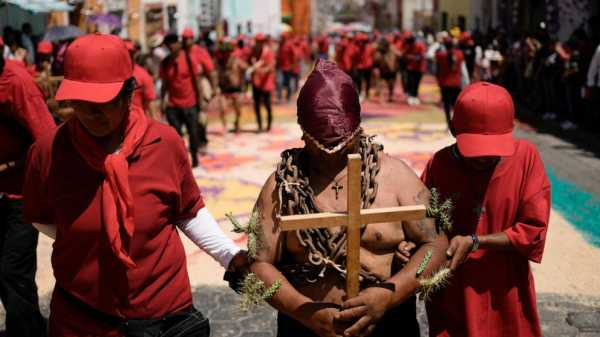
ATLIXCO, Mexico — Barefoot, half naked and blindfolded, throngs of middle aged men groan as they drag their bodies along blazing cobblestone streets.
Pieces of cactus sit lodged on their arms and legs, and 70-pound chains hang around their necks and clatter around their ankles as crowds watch them pass.
For these men, it’s not a form of torture, but rather a cherished tradition that has played out for more than a hundred years in the Mexican town of Atlixco.
Every year on Good Friday in the small Mexican town of Atlixco, more than a hundred men make the trek known as the Procesión de los Engrillados — the Procession of the Chained.
In this country where nearly 80% of the people are Roman Catholic, the participants believe it’s a way to give thanks or to pay penance for their sins.
“It’s an act of gratitude for all that God has given me, and a way to ask for forgiveness for all the bad I’ve done to be a better person,” said Martín Cazares, 42, who has participated in the march for two decades. “It helps me reflect.”
Chains wound around Cazares’ bare chest, a red cloth wrapped around his eyes and a crown of thorns rested on his head. He waited patiently for his turn, while event organizers tossed small, spiny chunks of cactus onto his legs, and those of the other marchers, where they stuck in the flesh.
Organizers say the story behind the tradition dates back to a man who was said to use witchcraft to win a woman’s heart. He went to a cemetery and cut off the finger of a dead man to make an amulet to win her love, the story goes.
But wracked with guilt, he decided to pay penance wearing heavy chains and trudging through Atlixco each Friday before Easter. Over the past century the tradition has gradually grown.
Sweat-drenched men walk more than a mile through the town of multicolored buildings and colonial churches two hours outside the capital Mexico City.
Hundreds of onlookers line the street as volunteers fan the chained men with pieces of cardboard and squeeze pieces of lime into their mouths — the only thing they are allowed to drink during their walk. Blood drips from the calves of some men as the volunteers pick up pieces of fallen cactus and lob them back at their bodies.
“The spines are very painful, and it’s exhausting,” Cazares said. “The heat suffocates you, and the exhaustion with the sun, the sun burning your feet, it’s too much."
Yet Cazares said he participates every year without fail.
Leticia Bautista, 58, who has lived in Atlixco her entire life, said she remembers watching with horror as her uncle joined the march for three years when she was a little girl.
“I think God forgives you for the simple act of asking for forgiveness," she said. “You don’t have to do such nasty things to your body.”
Others like Alicia Garcés, coordinator of the march, brush off criticisms that the procession is something morbid.
She feels the event is a tradition worth preserving, but she worries that participation has dropped off in recent years. That has coincided with a dip in Catholicism across Mexico, a country with one of the largest number of Catholics in the world.
Since 1990, the share of Mexicans who identify themselves as Catholic has dropped from just over 90% to 78%, according to Mexico’s 2020 census.
The cornavirus pandemic also dealt a blow to the Procesión de los Engrillados, and Garcés hoped this year's event would rekindle interest.
“For the people of this town, it’s very important that today, after three years of pandemic, we return to the streets to live this passion,” she said.
Sourse: abcnews.go.com






